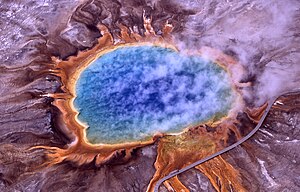An extremophile (from Latin extremus meaning "extreme" and Greek philiā (φιλία) meaning "love") is an organism that thrives in physically or geochemically extreme conditions that are detrimental to most life on Earth
Hot
Thermophiles, a type of extremophile, produce some of the bright colors of Grand Prismatic Spring, Yellowstone National Park
Cold
The search for intelligent life continues. The atypical alien life-form will likely not have a humanoid body, dark oval eyes and an elongated head. Any alien life forms we find could conceivably be single-celled microorganisms that live in environments inhospitable to life as we know it. Scientists have found life where we never though it could exist — in boiling water, inside rocks, under ice and at the bottom of the ocean. These forms of life are called extremophiles, and scientists are studying them for clues of what alien life could look like.
 Photo: Jon Taylor
Photo: Jon TaylorTo understand life on other planets, we have to understand how life on Earth originated and make a few assumptions. Since our life is carbon based, requires water and exists on a planet around a sun, the starting point for astrobiologists is similar in their search.
Asteroids, comets and meteorites are icy rocks that zip around in space, crashing into moons and planets, delivering minerals, water and amino acids — the basis for protein formation and the basis for life. To date, eight amino acids have been discovered in meteorites — a good indicator that there may be life out there.
Video
Nov. 7, 2011: Back in the 1970s, biologists were amazed to discover a form of life they never expected. Tiny microorganisms with ancient DNA were living in the hot springs of Yellowstone National Park. Instead of dissolving in the boiling waters, the microbes were thriving, ringing the springs with vibrant color.
Scientists coined the term extremophile, which means "extreme-loving", to describe the creatures--and the hunt was on for more. Soon, extremophiles were found living in deep Antarctic ice, the cores of nuclear reactors, and other unexpected places. Biology hasn't been the same since.
Could astronomy be on the verge of a similar transformation?
Researchers using a NASA space telescope named GALEX have discovered a new kind of extremophile: extreme-loving stars.
"We’re finding stars in extreme galactic environments where star formation isn't supposed to happen," explains GALEX project scientist Susan Neff of the Goddard Space Flight Center. “This is a very surprising development."

0 comments:
Post a Comment